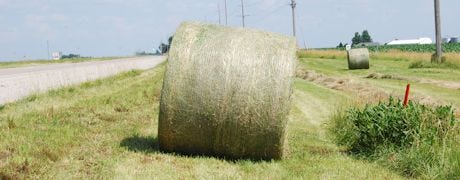July 9, 2013

The Iowa Department of Natural Resources will open up state land this summer to haying and grazing to help livestock farmers impacted by severe weather conditions. "This has been one of the most challenging weather patterns Iowa farmers have ever had to face and we want to be able to provide some additional options to our livestock producers," says DNR deputy director Bruce Trautman.
Most state lands in Iowa do not have proper fencing for cattle so farmers wanting to use the land for grazing would be responsible for setting up temporary electric fencing and watering tanks. That will make haying more likely to be the most viable option—as opposed to grazing.

"HIGHWAY HAY" HAS RESTRICTIONS: Some state-owned land in Iowa is being made available to livestock farmers for haying and grazing due to severe weather conditions this spring and summer, and the tight supply of forage. Also, harvesting of "highway hay" along state highways is being allowed if you have a permit from the Iowa DOT. Remember to observe mowing restrictions along state highway rights-of-way.
You'll have to set up temporary electric fencing if you want to graze state land
Haying and grazing can start after July 15 when the primary nesting season for upland birds has been completed. Land available is primarily the upland grassland areas, however, there are some additional opportunities for "flash grazing" in northeast Iowa and other limited opportunities on land not currently being leased to farmers. "The DNR is working very closely with the Iowa Governor's Office and all of our stakeholders to make emergency livestock forage available and to make sure that we are helping those who need assistance the most," says Trautman. Farmers interested in this opportunity should contact the Iowa Department of Natural Resources at 515-281-5918.
"Highway hay" is also available—keep in mind you need to observe mowing restrictions in state highway rights-of-way
Each year, landowners and others, including farmers, are allowed to harvest hay from highway rights of way by permit in Iowa. The Iowa Department of Transportation requires those permits, for several reasons, one of which is the protection of habitat for wildlife. The Iowa DOT begins the permitting process in the spring, but harvesting of hay is not allowed until July 15.~~~PAGE_BREAK_HERE~~~
"July 15 was chosen as a compromise for hay harvesting to begin, to both help those people wanting to harvest hay and to protect bird habitat," says Joy Williams, an agronomist with the Iowa DOT's roadside development section. "Many people would like to harvest hay sooner and then take a second cutting in September, but that would conflict with the nesting season. It's also hard on the native grasses and doesn't allow winter cover to develop very well for birds."
When early spring weather is cold and damp, later harvesting of hay from the right of way is even more important, especially for pheasant habitat. Pheasants nest several times throughout the year," says Todd Bogenshutz, the upland wildlife biologist with the Iowa Department of Natural Resources. "Sometimes nests are destroyed by floods. We probably had a lot of that occur this year. About 35% to 45% of pheasant, 62% of quail and 60% to 70% of songbird nests hatch after July first."
Rules for harvest periods must be followed, permit applications are required
The Iowa DOT has established two periods for harvesting grass within the state-maintained highway right-of-way.
* July 15 to September 1: For cool-season grasses and forage legumes (such as smooth brome, tall fescue, perennial ryegrass, alfalfa, birds-foot trefoil).
* July 15 to August 15: For areas containing warm-season native grasses (such as switchgrass, big bluestem, little bluestem, Indian grass, sideoats grama, Canada wild rye).
Here's what you need to know about permit applications: An Iowa DOT Harvesting and Mowing Permit Application form is available from DOT district offices or go online. The application covers three types of operations: 1) mowing only; 2) harvesting hay in large or small bales; 3) harvesting plant material other than hay with machinery, by hand or with hand tools. Landowners are allowed to mow within 200 yards of inhabited dwelling without a permit.
You May Also Like




